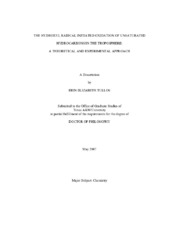| dc.description.abstract | Isoprene is the dominant non-methane organic compound emitted by vegetation
into the atmosphere, with a global emission rate of ~ 500 Tg yr-1. Its oxidation serves as
a major source of ground level ozone in North America during the summer months.
Despite the significant impact on tropospheric chemistry, questions remain concerning
the detailed oxidation mechanism. The initial step in the mechanism is the addition of
OH to form four distinct isomers. The relative branching between these isomers
influences the distribution of the final products. I present a comprehensive investigation
into the mechanistic details of early steps in the oxidation mechanism of unsaturated
hydrocarbons in the troposphere and employ theoretical and experimental techniques.
To understand the detailed kinetics of the initial OH addition to unsaturated
hydrocarbons, I first present a model developed for the ethylene-OH system. I present
the details of a robust two-transition state model. I extend the developed two-transition state model to the case of OH addition to isoprene. Excellent agreement with observed
temperature and pressure dependent rate constants affords a high confidence level in
understanding of the kinetics and in the calculated branching ratio of the initial OH
addition step.
I then focus attention on the subsequent reactivity of the OH-isoprene adducts.
Until recently, all four of the OH-isoprene adducts were supposed to have reacted with
O2 via addition to form alkylperoxy radicals. Previous computational results suggest that
two of the OH-isoprene adducts undergo an intramolecular cyclic isomerization
followed by hydrogen abstraction by O2 to form stable carbonyl compounds. I have
synthesized photolytic precursors, presenting a novel approach to probe the subsequent
reactivity of individual hydroxyalkyl radicals.
Initial verification of the cyclic isomerization pathway involved synthesis of the
photolytic precursor corresponding to the 1,3-butadiene-OH adduct. A culmination of
theoretical and experimental techniques allowed verification of the cyclic isomerization
pathway. I synthesized the photolytic precursor, which provided a single isoprene-OH
adduct. Employing laser photolysis/laser induced fluorescence, time-dependent
multiplexed mass spectrometry, velocity map ion imaging, and theoretical techniques,
we present the full characterization of the reactivity of the single isoprene-OH adduct in
the presence of O2. | en |


